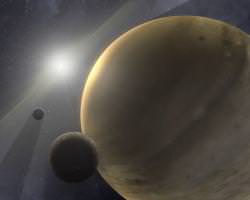 New research indicates that gas giants, like Jupiter and Saturn, form quickly after their stars do. In fact, they probably form within the first 10 million years of a star’s life, or else they never form at all.
New research indicates that gas giants, like Jupiter and Saturn, form quickly after their stars do. In fact, they probably form within the first 10 million years of a star’s life, or else they never form at all.
Continue reading “Gas Giants Turn Up Early After Star Formation”
White Dwarf Recently Consumed an Asteroid
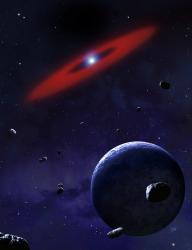 Astronomers have discovered a ring of metal-rich gas surrounding a relatively nearby white dwarf star that gives us a glimpse at the future of our own Solar System.
Astronomers have discovered a ring of metal-rich gas surrounding a relatively nearby white dwarf star that gives us a glimpse at the future of our own Solar System.
Continue reading “White Dwarf Recently Consumed an Asteroid”
Use Galactic Gravitational Lenses to Really See the Universe
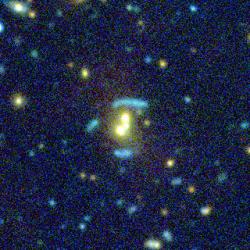 To see any distance in space, you need some kind of telescope. We’ve got some pretty powerful ones here on Earth, but nature has us beat with gravitational lenses. This is a phenomenon when a relatively nearby object passes directly between us and a more distant object. The gravity from the nearby object acts as like a telescope lens to bend light and magnify the more distant object.
To see any distance in space, you need some kind of telescope. We’ve got some pretty powerful ones here on Earth, but nature has us beat with gravitational lenses. This is a phenomenon when a relatively nearby object passes directly between us and a more distant object. The gravity from the nearby object acts as like a telescope lens to bend light and magnify the more distant object.
Continue reading “Use Galactic Gravitational Lenses to Really See the Universe”
Insanely High Resolution Photo of the Tarantula Nebula
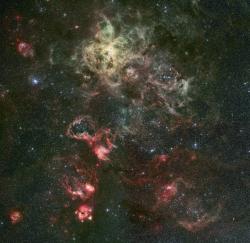 I’m not sure why, but the European Southern Observatory has decided to give their web servers and bandwidth a real workout with their latest photo release. But I’m glad they did.
I’m not sure why, but the European Southern Observatory has decided to give their web servers and bandwidth a real workout with their latest photo release. But I’m glad they did.
Continue reading “Insanely High Resolution Photo of the Tarantula Nebula”
Next Up, the COROT Space Telescope
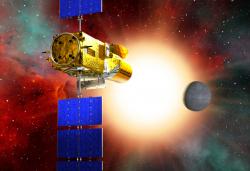 Step aside Hubble, Chandra, Spitzer, there’s a new space telescope ready for launch. On December 27, 2006, the European Space Agency is planning to launch its planet hunting, starquake finding COROT satellite.
Step aside Hubble, Chandra, Spitzer, there’s a new space telescope ready for launch. On December 27, 2006, the European Space Agency is planning to launch its planet hunting, starquake finding COROT satellite.
Continue reading “Next Up, the COROT Space Telescope”
Here’s a New Way to Explode: Hybrid Gamma-Ray Burst
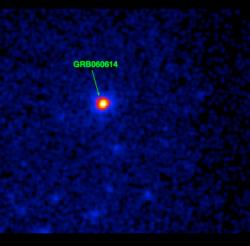 Just when you thought you’d figured out all the ways to blow up, nature reveals a new way. This latest class of explosion is called a hybrid gamma-ray burst, and it was discovered by NASA’s Swift satellite. As with most gamma-ray bursts, this explosion probably indicates the birth of a new black hole in the Universe; however, the explosion itself was different from what astronomers have seen before.
Just when you thought you’d figured out all the ways to blow up, nature reveals a new way. This latest class of explosion is called a hybrid gamma-ray burst, and it was discovered by NASA’s Swift satellite. As with most gamma-ray bursts, this explosion probably indicates the birth of a new black hole in the Universe; however, the explosion itself was different from what astronomers have seen before.
Continue reading “Here’s a New Way to Explode: Hybrid Gamma-Ray Burst”
Happy Hubble Holidays
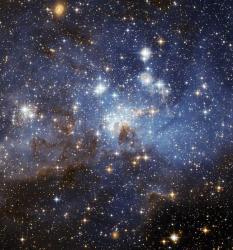 The fine folks at the Hubble Space Telescope released this photograph today to celebrate the holidays. I’m not sure which holiday specifically, but anytime is a good time to release beautiful new photographs from Hubble.
The fine folks at the Hubble Space Telescope released this photograph today to celebrate the holidays. I’m not sure which holiday specifically, but anytime is a good time to release beautiful new photographs from Hubble.
Continue reading “Happy Hubble Holidays”
How Multiple Star Systems Come Together
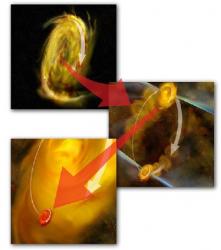 Multiple star systems are a staple of science fiction. The heroes stumble across a parched desert searching for some escape from the three suns burning in the sky. As they struggle for their lives, perhaps our protagonists might take a moment to consider the chain of astronomical events that brought them to this moment.
Multiple star systems are a staple of science fiction. The heroes stumble across a parched desert searching for some escape from the three suns burning in the sky. As they struggle for their lives, perhaps our protagonists might take a moment to consider the chain of astronomical events that brought them to this moment.
Continue reading “How Multiple Star Systems Come Together”
Spitzer Looks Right Back to the First Stars
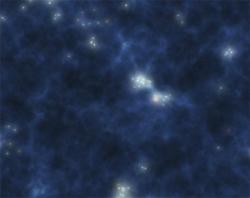 After the Big Bang there were the first stars. Astronomers think these monsters contained more than 1,000 times the mass of our Sun, and poured out torrents of radiation. They didn’t last long, but they began the cycles of star birth, death, and detonation that helped to create the Universe as we see it today; as well as all the heavier elements.
After the Big Bang there were the first stars. Astronomers think these monsters contained more than 1,000 times the mass of our Sun, and poured out torrents of radiation. They didn’t last long, but they began the cycles of star birth, death, and detonation that helped to create the Universe as we see it today; as well as all the heavier elements.
Continue reading “Spitzer Looks Right Back to the First Stars”
Star Formation Factory
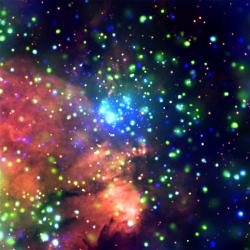 You’re looking at a star forming region known as W3. It’s located about 6,000 light-years from Earth in the Perseus arm of the Milky Way. It’s just a small part of a much larger molecular cloud complex called the W4 superbubble (not pictured here), which extends about 100 light-years across. As that superbubble expands, it’s giving these clouds of dust and gas just the bump they need to collapse and get down to the business of furious star formation.
You’re looking at a star forming region known as W3. It’s located about 6,000 light-years from Earth in the Perseus arm of the Milky Way. It’s just a small part of a much larger molecular cloud complex called the W4 superbubble (not pictured here), which extends about 100 light-years across. As that superbubble expands, it’s giving these clouds of dust and gas just the bump they need to collapse and get down to the business of furious star formation.
Continue reading “Star Formation Factory”
